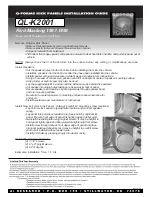
34
1. Shelf speakers
Our smaller speakers are ideal for
installation on shelves in wall recesses, or
on other types of shelf.
Shelves and other types of furniture tend
to amplify the lower frequencies, and to
avoid this effect we recommend setting up
the speakers on damping material or
spikes, which de-couple the speakers
acoustically.
Please note that any loose items of
furniture, such as movable shelves and
wood or glass doors, can very easily be
set vibrating by the speakers.
You can avoid resonant effects by ap-
plying strips of felt or similar material
between the loose parts.
2. Floor-standing speakers
floor-standing loudspeakers can be
mounted on spikes in order to provide
optimum low-frequency signal coupling to
the floor.
Note:
Children can be careless when they are
playing, so please take this into ac-count if
you intend using speaker stands or
standing speakers on the floor. Either
locate them where they are safe from
children, or take extra measures to
prevent them falling over.
The spikes have very sharp points! To
avoid injury please handle them with
extreme care, and keep them well away
from children.
3. Digital Surround
The
loudspeaker range includes all
the components you need to set up a
complete surround loudspeaker system. A
complete,
no-compromise
multi-channel
home cinema system requires five, six or
more loudspeakers of equal quality, catering
for the front, centre and rear of the sound
stage. Active sub-woofers are used for the
bass range.
In contrast to earlier analogue surround
systems, a digital surround system
includes five, six or more equal-value
channels plus a sub-woofer channel. All
the channels are independent and feature
unlimited frequency ranges. This means
that the transmission characteristics of all
channels should be identical, i. e. all paths
require electronics of the same high
quality, and all the loudspeakers should be
of similar quality. The point of this level of
sophistication is best explained by the
following example:
Imagine that the heavyweight main
character in a film runs from front to back;
if the rear loudspeakers are smaller than
those at the front, he will turn from a
heavyweight into a lightweight as he
proceeds.
We recommend using loudspeakers which
are as nearly identical as possible.
If this level of refinement seems too
extreme for you, or if you simply don’t
have the space, the alternative is to
assemble your surround system using
other speakers from the extensive
range. In either case the arrangement of
loudspeakers shown below should be
observed:
















































